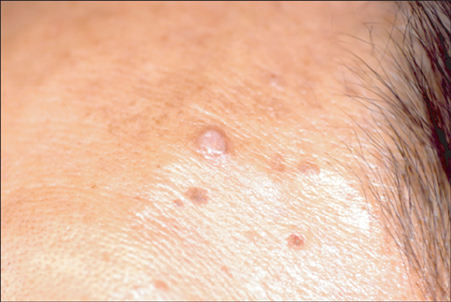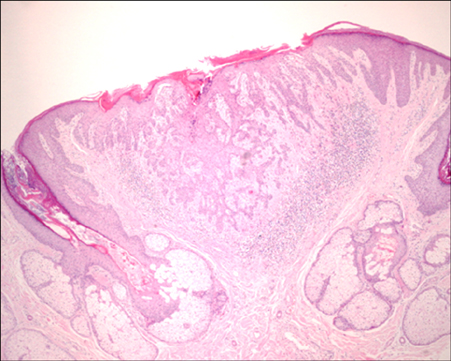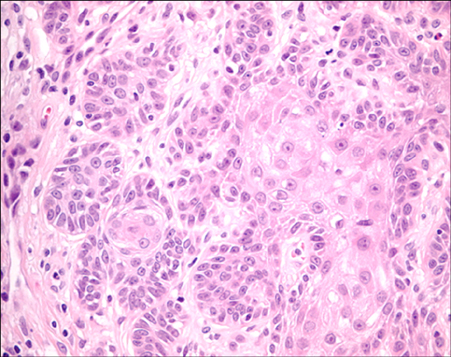Ann Dermatol.
2010 May;22(2):229-231. 10.5021/ad.2010.22.2.229.
A Case of Basaloid Follicular Hamartoma
- Affiliations
-
- 1Department of Dermatology, Myongji Hospital, Kwandong University College of Medicine, Goyang, Korea. dermy@kd.ac.kr
- 2Department of Pathology, Myongji Hospital, Kwandong University College of Medicine, Goyang, Korea.
- KMID: 2265403
- DOI: http://doi.org/10.5021/ad.2010.22.2.229
Abstract
- Basaloid follicular hamartoma (BFH), uncommon rare benign neoplasm connected to the adnexal structures, presents with multiple clinical manifestations that can develop into basal cell carcinoma. BFH may be congenital or acquired, and the congenital form can be further divided into the generalized and unilateral type, and the acquired form may present as localized and solitary lesions. Congenital, generalized BFH is associated with systemic diseases such as alopecia, cystic fibrosis, hypohidrosis, and myasthenia gravis. In contrast, sporadic cases are observed as unilateral or localized lesions. BFH shows thick cords and thin strands of anastomosing basaloid proliferations that arise from hair follicles and are enclosed by loose fibrous stroma. Here, we report a 70-year-old man with an acquired, solitary form of BFH.
Keyword
MeSH Terms
Figure
Cited by 1 articles
-
Segmentally Arranged Hyperpigmented Basaloid Follicular Hamartoma
Tae Hyung Kim, Seung Joon Oh, You Chan Kim, Mi Ryung Roh
Ann Dermatol. 2015;27(2):218-220. doi: 10.5021/ad.2015.27.2.218.
Reference
-
1. Lee HJ, Lee WJ, Chang SE, Lee MW, Moon KC, Choi JH, et al. A case of familial basaloid follicular hamartoma syndrome. Korean J Dermatol. 2007. 45:1070–1073.2. Patel AB, Harting MS, Smith-Zagone MJ, Hsu S. Familial basaloid follicular hamartoma: a report of one family. Dermatol Online J. 2008. 14:14.
Article3. Choi SW, Ryu YS, Kim HO, Kim CW. A case of basaloid follicular hamartoma combined with basal cell epithelioma. Korean J Dermatol. 1998. 36:148–151.4. Han ES, Seo SJ, Hong CK, Song KY, Ro BI. A case of basaloid follicular hamartoma. Korean J Dermatol. 1997. 35:303–306.5. Walsh N, Ackerman AB. Basaloid follicular hamartoma: solitary and multiple types. J Am Acad Dermatol. 1993. 29:125–129.
Article6. Carney RG. Linear unilateral basal-cell nevus with comedones; report of a case. AMA Arch Derm Syphilol. 1952. 65:471–476.7. Brownstein MH. Basaloid follicular hamartoma: solitary and multiple types. J Am Acad Dermatol. 1992. 27:237–240.
Article8. El-Darouti MA, Marzouk SA, Abdel-Halim MR, Zidan AZ, Fawzy MM. Basaloid follicular hamartoma. Int J Dermatol. 2005. 44:361–365.
Article9. Smith KJ, Skelton H. Basaloid follicular hamartomas associated with autoimmune disease: a possible role for retinoids in therapy. J Am Acad Dermatol. 2003. 49:1067–1070.
Article10. Kaiser A, Spence RJ, Parwani A, Tihan T, Barrett TL. Basaloid follicular hamartoma with trichoblastomatous proliferations. J Cutan Med Surg. 2003. 7:395–398.
Article11. Nelson BR, Johnson TM, Waldinger T, Gillard M, Lowe L. Basaloid follicular hamartoma: a histologic diagnosis with diverse clinical presentations. Arch Dermatol. 1993. 129:915–917.
Article12. Jih DM, Shapiro M, James WD, Levin M, Gelfand J, Williams PT, et al. Familial basaloid follicular hamartoma: lesional characterization and review of the literature. Am J Dermatopathol. 2003. 25:130–137.13. Oseroff AR, Shieh S, Frawley NP, Cheney R, Blumenson LE, Pivnick EK, et al. Treatment of diffuse basal cell carcinomas and basaloid follicular hamartomas in nevoid basal cell carcinoma syndrome by wide-area 5-aminolevulinic acid photodynamic therapy. Arch Dermatol. 2005. 141:60–67.
Article
- Full Text Links
- Actions
-
Cited
- CITED
-
- Close
- Share
- Similar articles
-
- A Case of Familial Basaloid Follicular Hamartoma Syndrome
- A Case of Basaloid Follicular Hamartoma Combined with Basal Cell Epithelioma
- A Case of Multiple Basaloid Follicular Harmatoma
- A Case of Basaloid Follicular Hamartoma
- Happle-Tinschert Syndrome: A Case Report of Unilateral Segmentally Arranged Basaloid Follicular Hamartoma with Scoliosis and Review of Literature




